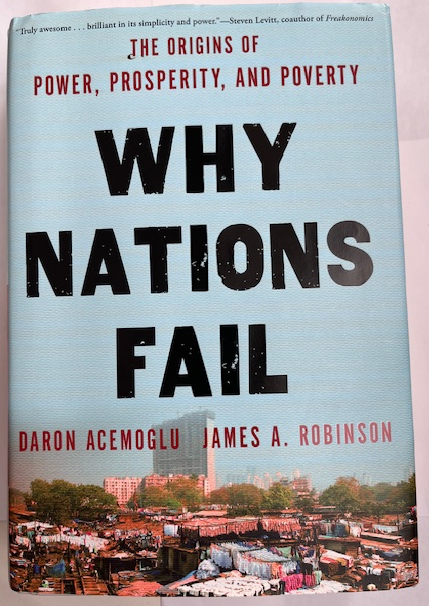現在読んでいる下記の洋書 ”Why Nations Fail”(邦題:国家はなぜ衰退するのか)に関する記事を何回かに分けて書いてみたいと思います。
実は、大分前(2012年頃)に購入したものの積読状態だったのですが、著者のAcemoglu教授達が2024年にノーベル経済学賞を受賞したこともあって、本書を改めて手に取った次第です。
序章(Preface)を除き、本書は全15章から成り立っています。
1. SO CLOSE AND YET SO DIFFERENT
2. THEORIES THAT DON’T WORK
3. THE MAKING OF PROSPERITY AND POVERTY
4. SMALL DIFFERENCES AND CRITICAL JUNCTURES: THE WEIGHT OF HISTORY
5. “I’VE SEEN THE FUTURE, AND IT WORKS”: GROWTH UNDER EXTRACTIVE INSTITUTIONS
6. DRIFTING APART
7. THE TURNING POINT
8. NOT ON OUR TURF: BARRIERS TO DEVELOPMENT
9. REVERSING DEVELOPMENT
10. THE DIFFUSION OF PROSPERITY
11. THE VIRTUOUS CIRCLE
12. THE VICIOUS CIRCLE
13. WHY NATIONS FAIL TODAY
14. BREAKING THE MOLD
15. UNDERSTANDING PROSPERITY AND POVERTY
現在、世界の国々では所得水準や生活水準に大きな差が生じています。第1章の冒頭では、Nogalesという都市を例に議論がスタートします。Nogalesは国境により、北側の米国アリゾナ州と南側のメキシコのソノラ州に分断されています。
北側のNogalesと南側のNogalesでは、地理的に隣接しているにもかかわらず、生活(所得)水準や教育水準、治安や乳幼児の死亡率などが全く異なります。
「なぜこのような差異が生じるのか」について、過去の歴史を参照しながら解明していこうとするのが本書です。
今回は、第1章と第2章について、感想を述べたいと思います。
【English】
The city of Nogales is divided into two halves by a fence. On one side is Nogales, Arizona, a relatively prosperous town in the United States. On the other side is Nogales, Sonora, a Mexican city characterized by poverty and limited opportunities. Despite their shared geography, the two cities experience starkly different realities.
This book challenges widely accepted theories about global inequality, including the “geography hypothesis,” the “culture hypothesis,” and the “ignorance hypothesis.”
The “geography hypothesis” attributes economic success to geographical factors such as climate and disease. The “culture hypothesis” links prosperity to religion, ethics, and societal values, while the “ignorance hypothesis” asserts that underdevelopment is due to poor policy decisions by innocent leaders.
The authors dismiss these hypothesis and propose that the true determinant of a nation’s prosperity lies in its institutions—both political and economic.
Acemoglu and Robinson introduce a framework based on two types of institutions: inclusive and extractive.
Inclusive institutions encourage broad participation in economic and political activities, uphold the rule of law, and provide incentives for innovation. In contrast, extractive institutions concentrate power and wealth in the hands of a few elites, exploiting the broader population’s resources and wealth.
The contrast between the two Nogales cities is explained by the significant institutional differences between the United States and Mexico.
Another interesting point is that institutions evolve over time, shaped by historical processes, a concept known as “path-dependent” change.
Spain and the United Kingdom provide compelling examples of how path dependency influences national outcomes.
Both Spain and the United Kingdom began their colonial ventures with similar strategies of exploiting indigenous populations. However, their respective focus areas led to divergent outcomes.
Spain focused heavily on resource extraction, particularly in the form of silver and other minerals from the vast mines in South America.Thus, extractive institutions concentrated political and economic power in the hands of a few elites, prioritizing short-term resource exploitation and leaving a legacy of inequality and stagnation.
In contrast, the United Kingdom’s colonies in North America were primarily driven by agriculture and the demand for labor shaped an distinct economic system and inclusive institutions.
This divergence illustrates how initial economic choices, influenced by the resources available and the need for labor, shaped the future of these colonial empires.



コメント